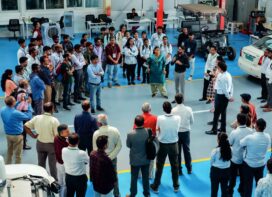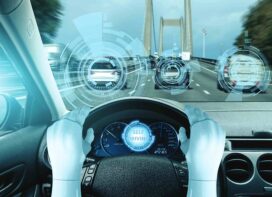The increasing traffic density on city roads is leading to Red light and Speed Violation and consequently to increased road accidents. Indian cities are trying to be Smart and Safe with the use of Video Surveillance and advanced traffic management systems. TrafficInfraTech spoke to Traffic Police officials of various states to find out the system being put in place for speed enforcement and safety.
 When the present government announced the idea of creating 100 smart Indian cities, it created waves in the traffic industry. A city has to be safe, after all, to be smart!
When the present government announced the idea of creating 100 smart Indian cities, it created waves in the traffic industry. A city has to be safe, after all, to be smart!
As the population of the cities increased, the vehicular travel also increased leading to congestion on roads. With the growth of the urbanization and population, there has been a tremendous growth in the traffic related problems like traffic jams, accidents and traffic rule violation at the heavy traffic signals etc. According to a recent report by National Highways Authority of India, the average number of vehicles in India is growing at the rate of 10.16% annually.
While the Government has been laying emphasis on building roads, bridges and underpasses and creating alternative modes of mass public transport systems, this may not be sufficient to address the traffic congestion. Traffic management has always posed a challenge in India and it may continue to become more difficult with every passing day unless we start building some intelligence into the way we look at resolving these issues.
The solution lies in leveraging advanced technologies and intelligent solutions. Some intelligent traffic management systems are already being implemented in cities like Delhi, Hyderabad and Bangalore making an impact in the form of reduced congestion and less fatal accidents.
Application of ITMS in Delhi Intelligent Transport System is essentially the technology coming in aid for all transport related problems. The system involve use of CCTVs in strategic junctions, vehicle presence detectors, in-road magnetic loop detectors and other remote video surveillance devices to assure automated control in good or bad weather and in varying traffic volumes.
In the recent Union Budget, Delhi Police was allotted `5,372.88Cr, which is aimed at sprucing up traffic infrastructure, induction of latest technology and capacity building of the force.
A state-of-the-art technology is being planned by the Delhi Traffic Police with a view to bring efficiency and efficient management of traffic on roads. A proposal of Intelligent Traffic Management System Project as a Safe City project is being planned in Delhi for which the Delhi Police had appointed Price Water Cooper as the consultant. Under the system, there would be an integrated system of gantry mounted speed measurement devices, red light speed violation check cameras, mobile traffic law enforcement units (interceptors), the output of which will all be compiled at traffic control room for collation of data, issue of traffic notices/challans and detection of repeat violators for subsequent enhanced punishment. A Detailed Project Report of ITMS has already been submitted by the Delhi Police to the Ministry of Home Affairs, Govt. of India, for consideration. Presently, the consultant is working on preparation of “Request for Proposal”. The project shall be undertaken for implementation during this 12th Five Year Plan 2012-17.
Variable Message Sign Boards would be also installed at important locations on corridors and major roads which will inform major break down on signal free roads, longer queues and traffic congestion and road specific directions which will result in avoiding travel time delays. The major features of the system are: Optimized real time traffic signal control, Surveillance camera to check junction behavior and violations, Variable Message Sign Board and Centralized Command & Control Centre.
 Kolkata goes for CCTV in Buses
Kolkata goes for CCTV in Buses
The state-run Calcutta State Transport Corporation has installed CCTVs in 632 buses introduced under the JnNURM scheme to make travel safer for passengers, especially women. Two CCTVs are installed inside each bus, one in the front, another at the middle, while the third one is placed outside at the rear of the vehicle. Each bus has a storage capacity of 100GB.
Muktesh Chander, Special Commissioner (Traffic), Delhi, said, “The Delhi Police has embarked upon a major modernization plan for further elevating the safety of road users through use of latest technology in traffic regulation and enforcement which matches the technological standards being adopted world-wide. The modern technology will be undertaken in phases and shall cover all strategic and vulnerable areas of the city. In line with the priorities of Delhi Traffic Police, the unit has focused on the following four vital areas viz.: Regulation, Enforcement, Education and Engineering. In addition, special enforcement drives are undertaken from time to time, to create an impact by focussed and concerted efforts.”
The increased level of safety of road users has largely been possible owing to sustained efforts of the Delhi Police towards modernization and use of available modern gadgets such as alcometers, interceptors, state-ofthe- art traffic signals, e-challaning system, etc. in traffic regulation and enforcement.

“Design and Conditions of roads & vehicles are major challenges”
Speaking on the major factors influencing the occurrence of accidents on the Delhi roads, Muktesh Chander said, “Over-speeding, red light jumping and wrong side driving not only cause traffic problems, but also result in occurrence of road accidents on Delhi roads. During the last five years, the Delhi Traffic Police has been successful in curbing fatal accidents to a commendable extent and saving precious human lives thereby increasing the overall safety of road users in the NCT of Delhi. The fatal accidents have reduced from a high of 2272 in the year 2009 to 1629 in 2014 while 2325 and 1671 persons lost their lives respectively in the corresponding years. The decrease in the rate of fatal accidents and fatalities has been gradual every successive year and the Delhi Traffic Police has been successful in saving precious lives from year to year.”
In spite of regular upkeep of the available technology, training of officers in handling such equipment, their regular maintenance, constant upgradation and improvement in the technology are certain challenges faced by the traffic personnel. Chander, explained, “Design and condition of roads and vehicles, coupled with road users capacity and conduct, are one of the major factors behind occurrence of road accidents. Certain accidents occur despite best precautions because of defect in roads and difficult driving conditions or hostile environment. Similarly, defective vehicle designs tend to accentuate road accident probability. Such accidents can be prevented with appropriate intervention of civic authorities maintaining roads and laying down norms for safe vehicle designs. If we are able to segregate pedestrians’ movements from the vehicular traffic on Delhi roads, we would be able to reduce the accidents considerably.”
The footpaths/pedestrian paths are mostly encroached by shopkeepers, roadside mechanics and vendors compelling the pedestrians to move on to the roads. The pedestrian facilities like foot-over bridges, subways, pelican signals etc. have been provided at a number of places but the facilities seem to have fallen short of the actual demand. Resultantly, hordes of pedestrians are observed crossing the roads from anywhere. The much delayed project of Eastern and Western Peripheral Expressway around NCR has caused unwarranted movements of non-destined commercial vehicles using the city as a transit corridor.
 TrafficInfraTech Magazine Linking People Places & Progress
TrafficInfraTech Magazine Linking People Places & Progress


